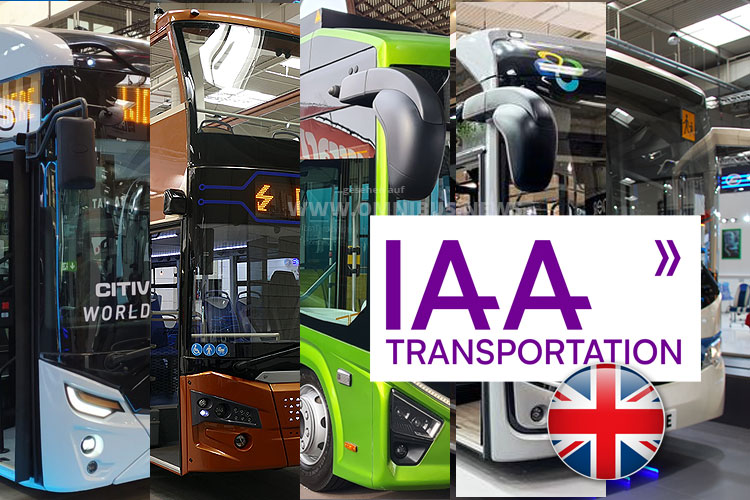
A first look back at the buses at the IAA 2022. Photo: Schrader, Schreiber, VDA; Assembly: omnibus.news
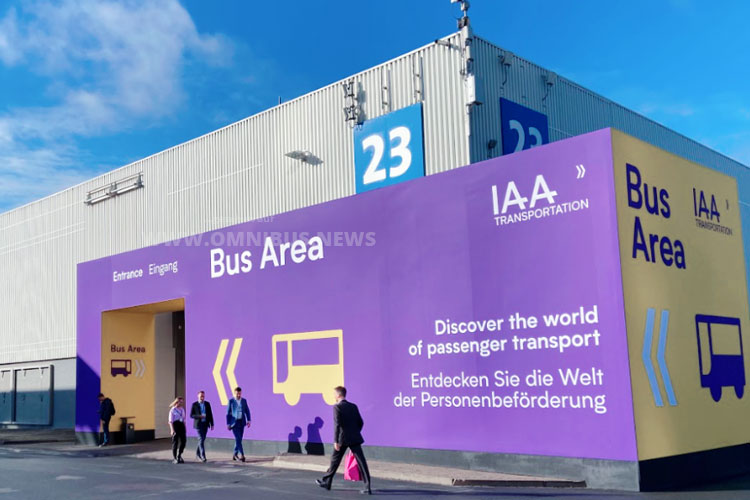
The IAA Transportation 2022 not only got a new name, but also a new concept including a Bus Area. Photo: omnibus.news
The first IAA with a new concept is runnig, and InnoTrans has also started. Why the VDA, with Deutsche Messe AG in the background, set the date parallel to InnoTrans, or why Messe Berlin set it parallel to IAA Transportation, is a question that those responsible should clarify.
It is the decade of the bus, as is repeatedly said in the industry. Why, then, do there have to be two trade fairs at each of which the bus is merely an ornamental accessory? It’s time to give the bus its own trade show beyond trucks and vans or rail vehicles. And a date of its own, because for those who went to Hanover and also Berlin to experience the buses and innovations, this year it was exhausting and stressful days somehow between the worlds. Classics in Hanover, innovations in Berlin?
IAA Transportation and InnoTrans cannot be divided up so simply. In Hanover, the VDA tried to compete with the Bus Area and world premieres with the showcase in the Summer Garden in Berlin. Isolated rain showers then also revealed the weak point of the Berlin concept: presenting buses in the open air allows spontaneous test drives in the oval of the Sommergarten, but also leads to unwanted breaks when it rains. Even the umbrellas distributed by some bus manufacturers can only help to a limited extent.
The deck chairs in Berlin allow visitors to take a breather and look at the hustle and bustle with a little distance. The buses on display at InnoTrans are lined up next to each other. Anyone who still remembers Bus2Bus, which uses the exhibition halls in addition to the Summer Garden, is hoping for an independent bus trade fair in Berlin.
In 2022 one felt between the worlds, sometimes one heard that the one or other bus interested person had a bad conscience, if one decided for only one fair attendance. Could one have missed something then? That can be decided after reading the following news of the omnibus exhibits.
IAA Transportation had a bit of a head start, as it started on 9/20, counting the press day already on 9/19. Therefore today first an overview of the bus novelties (with photo) from Hanover, details to the novelties follow in individual messages. Daimler Buses invited on 18.9. already to Hanover, in order to show the journalists in the context of the Medianight among other things also the innovations of the bus division, because these were not shown then until 25.9.2022 at the exhibition booth.
Striking: While four years ago one had to search for commercial vehicles with purely electric drives, this year it was the classic internal combustion engines that were almost exotic. Almost all exhibitors focused on exciting solutions in the truest sense of the word in Hanover. Obviously, by 2022 no manufacturer could afford to do without e-mobility solutions.
And something else stood out: Long operating times and or high performance are in demand in the commercial vehicle sector. When batteries reach their (performance) limits, fuel cells are said to be the solution. But there were also combustion engines on display that use hydrogen as a fuel.
The minibus specialists from Altas Auto showed the Novus Cityline LW, a fully electric minibus, in Hanover. The dealer network was expanded in Germany and Switzerland in time for the company’s 20th anniversary. Proudly, Edvardas Radzevičius, CEO of the company, explained that the order situation is good and they are looking to grow even more for 2023.
The company plans to generate at least 20 percent of its sales from electric buses next year and become fully electric by 2025. While the vehicles are mass-produced, Altas Auto relies on technology from Elinta Motors for electric motors, batteries and control systems.
In terms of performance, there is talk of a 150 kW E-motor and a battery capacity of 115 kWh. This should give a range of up to 270 kilometers, which should be enough for a whole day’s urban use of the minibuses, even with a heated or cooled cabin. After that, charging with up to 70 kW via CCS is required.
At the IAA, BYD showed the E-Bus Blade chassis as well as an updated model of the E-Bus series. The E-bus chassis was the highlight here, as it offered an extremely safe and extremely durable battery. The safety of the concept was established with the nail penetration test, which is considered the „ultimate safety test“ for batteries.
The blade battery gets its strength from CTP (cell to pack) technology. The space-saving design, he said, allows for a 50 percent reduction in space requirements and creates larger battery capacities for longer ranges while reducing chassis weight.
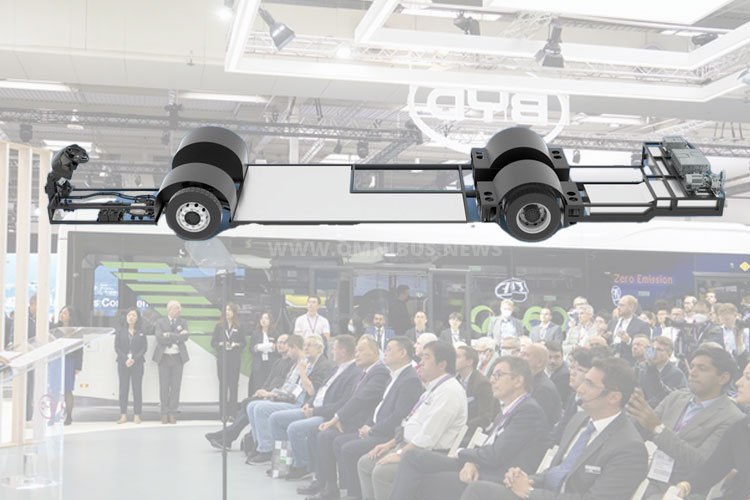
BYD showed an e-bus chassis at the press conference. Photo: BYD, Schreiber; Assembly: omnibus.news
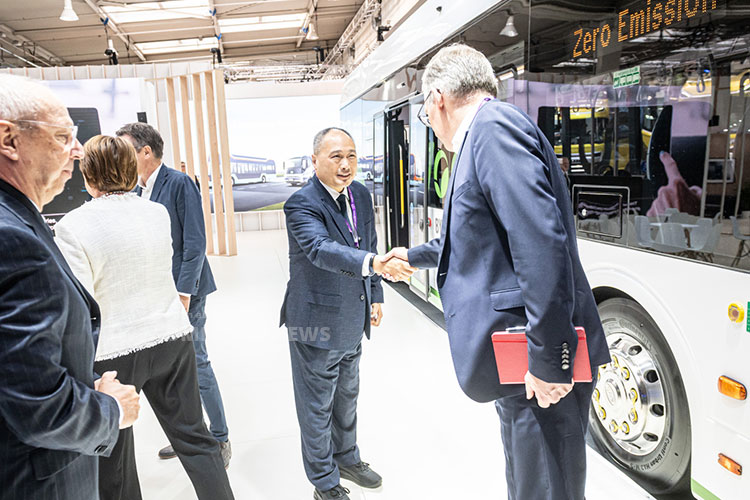
Isbrand Ho, BYD Europe boss, welcomes VDA Managing Director Jürgen Mindel on a tour of the BYD stand. Photo: VDA
Heilig’s Bleche – what the revamped flagship from, the Setra Series 500, now has to offer would have belonged on the concourse and would have been a true star turn: Visually sharpened, the brand name now catches the eye, especially on the side, but the far more important innovations took place under the still neat sheet metal dress.
Daimler Buses has made a name for itself with assistance systems, and now ABA5 and Active Drive Assist 2 are available in the Setra coach. The intelligent technology not only warns of (perhaps unintentional) lane departure, but can now hold it automatically. It can also automatically initiate smooth emergency braking in the lane – even when cornering!
For trips in the city center, convertible double-deckers have become popular in many places. Güleryüz from Turkey is now showing the right electric sightseeing double-decker in Hanover. The Turkish bus manufacturer, which, according to its own information, sends 700 buses (now with a new front mask, the „smiling face“) out on the road every year, is thus also living up to its company name visually.
In Germany, 45 Panora Sightseeing buses are currently on the road. Güleryüz emphasizes that this vehicle has the largest passenger capacity in its class: 74 seats and eight standing places, as well as a separate place for wheelchair passengers. Whether destination sign displays, multilingual announcements or bistro tables in the lower deck, what customers want is delivered.
When asked about the technology installed, Xhevdet Ajvazi, the managing director of Güleryüz Europe, is reserved, but makes it clear that the lightweight double-decker would consume one kilowatt hour for every kilometer. And in view of the daily mileage of a sightseeing bus, the performance would be more than sufficient. More details in one of the next reports on omnibus.news.
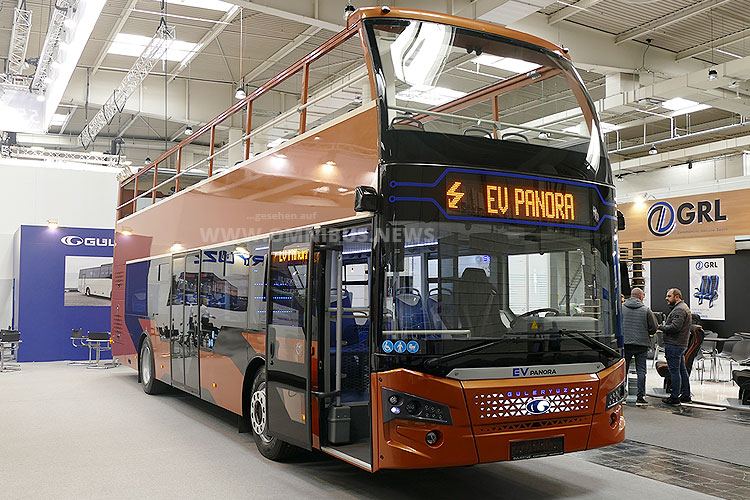
Gülerüz showed a BEV variant of the Panora sightseeing double-decker in Hanover. Photo: omnibus.news/Schrader
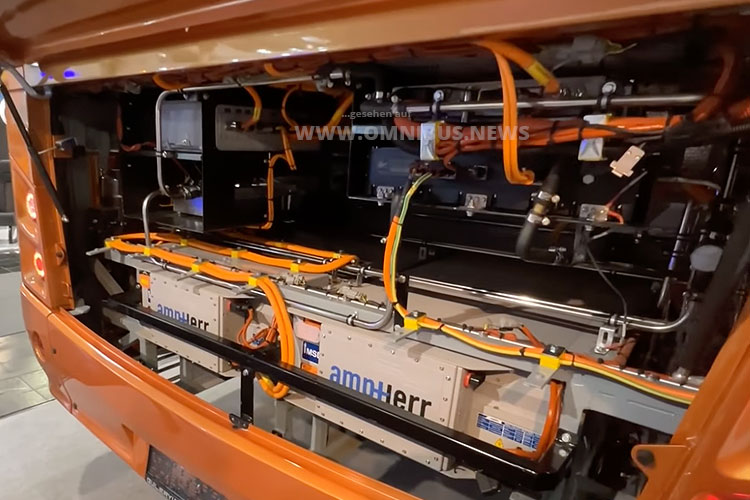
For the electric drive uses the classic engine compartment in the rear. Photo: omnibus.news/Schreiber
Anadolu Isuzu also wants to score points on the German market with electric buses: With its own sales department, including after-sales and service, the company hopes to achieve a breakthrough. The Turks presented the world premiere of the CitiVolt 12, which will be able to carry a good 100 passengers, 37 of them seated. Anadolu Isuzu will use Proterra batteries with 247 to 495 kWh.
These will be installed on the roof and are said to be good for a range of up to 500 kilometers. Other familiar components are also on board. The electric bus can be recharged in three hours with 150 kilowatts. A clever design detail: The destination display is not only located at the front, but extends around the corner and is generously visible above the front entrance door!
How little esteem the bus is held in by the organizers is shown, among other things, by the fact that on its own website under the heading IAA Adventure on the second day of the trade show it is written that at the stand of Anadolu Isuzu one can find novelties from the world of buses. Among other things, a CNG bus could be viewed and explored there – was the world premiere overlooked?
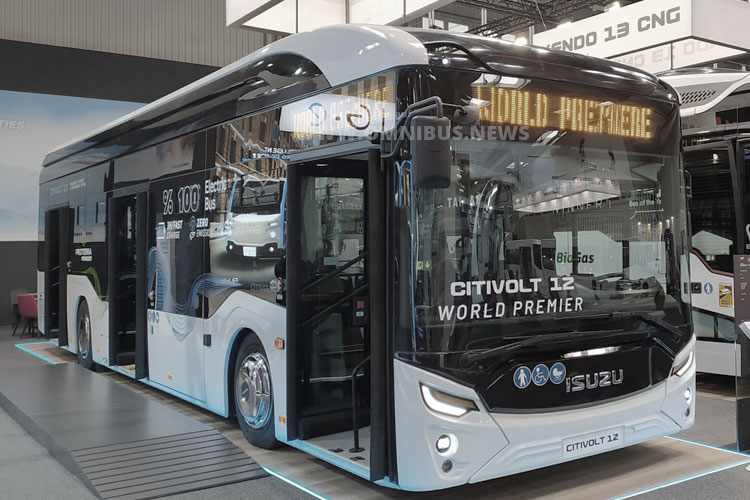
As a world premiere, Anadolu Isuzu showed the CitiVolt 12. omnibus.news/Schrader
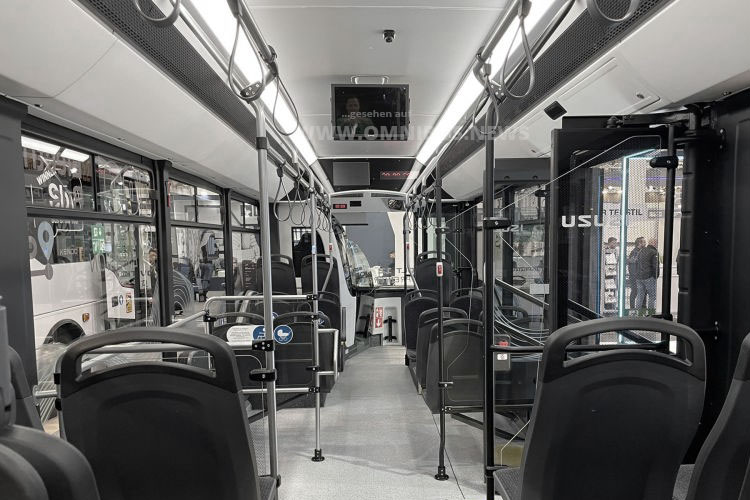
View into the passenger compartment of the new Isuzu Citivolt12. Photo: omnibus.news/Schrader
Iveco exhibited two buses in Hanover: The E-Way electric bus (on the indoor stand) and the conventionally powered Streetway, both in 12m versions. On the stand, the logo also shone for the first time in its new color, „Energy Blue“, which stands for determination and future orientation, according to Hanover.
Karsan presented a 12m e-Ata Hydrogen as a world premiere in Hanover. According to the Turkish bus manufacturer, the fuel cell-powered bus can carry 95 passengers and has a range of at least 500 kilometers. To make this possible, a 70 kW fuel cell has been installed, and a battery with a capacity of 30 kWh is also on board as an auxiliary power source.
As with the competition, Karsan also relies on lightweight tanks made of composite material to store the hydrogen. Their capacity was stated at 1,500 liters during the presentation. The hydrogen capacity in kilograms is 37.5 kg, the pressure 350 bar.
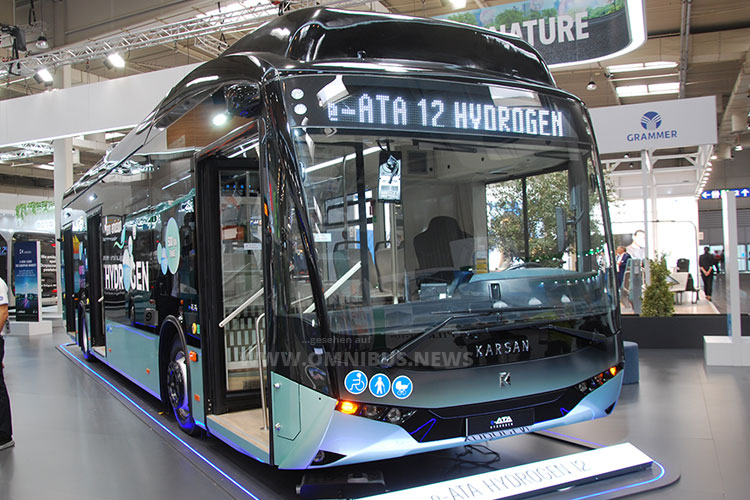
World premiere at the IAA Transportation 2022: The e-Ata Hydrogen from Karsan. Photo: omnibus.news/Marquardt

Der Fahrgastraum orientiert sich an der e-Ata-Baureihe. Foto: Sustainable Bus
Keyou specializes in the conversion of conventional combustion engines to emission-free hydrogen engines. In Hanover, a well-known prototype was presented in the form of a Solaris-based city bus. According to Keyou, the hydrogen engine with Keyou Inside technology does not require exhaust gas aftertreatment and has an output of 210 kW (286 hp).
Keyou states a range of at least 500 km. The bus remains below the zero emission CO2 limit defined by the EU in the WHTC reference cycles, so it also meets the Euro-6 emissions standard. „With our prototype, we are showing that the hydrogen engine technology also works in practice,“ says Thomas Korn, CEO of Keyou. Testing is now underway, he added, and a driver trial will be conducted together with customers at the end of 2023.
Austrian minibus specialist K-Bus is also involved in the field of electromobility: it has already delivered more than 80 e-solar buses, says Stefan Kutsenits. Whether citizens‘ bus (with eight passenger seats) or city bus (with space for 30 passengers), the vehicles have proven their suitability for everyday use. Batteries with 50 to 100 kWh are available, depending on customer requirements, and up to 250 km can be covered with one battery charge.
Stefan Kutsenits told omnibus.news that in addition to diesel, CNG and electric drives, the drive portfolio would soon be supplemented by hydrogen or a fuel cell. The technical basis comes from Toyota, which is already used in the BEV E-Solar-City. BEV vehicles have been available since 2017, and demand and sales have been rising for years, Kutsenits noted.
MAN, like Daimler Buses, did not show any buses at its booth, but it did receive the coveted title of „Bus of the Year 2023,“ which an international jury traditionally awards to a regular-service bus at the IAA. In the run-up to the IAA Transportation, MAN had provided information on the expansion of its e-bus family: A 10.5m short Lion’s City E – modularly derived from the E-bus modular system – now rounds off the portfolio at the bottom end.
Nesobus came from Poland to present an FCEV bus. They are currently building a factory, and by the end of 2023 the first vehicles will be rolling out of production, which will start next year – in 2023 the Poles plan to have 50 units.
The Polish hydrogen bus is a joint project of Polsat Plus Group and ZE PAK. One company is providing the bus, the other the „fuel.“ According to the manufacturers, the Nesobus will consume around 7 kg per 100 kilometers. An18m-long articulated bus is also planned, and 35 vehicles are scheduled to leave the factory when production starts in 2023.
Proven components are used for the drive system, the fuel cell with 70 kW comes from Ballard, the hydrogen is carried in five Hexagon tanks with a pressure of 350 bar, a total of 37.5 kg, as Nesobus explained. Two LTO batteries with a capacity of 15 kWh each are used for energy storage. The range mentioned in Hanover is 500 kilometers.
Nesobus relies on the AxTrax AVE 130 electric axle from ZF. The bus can be equipped flexibly according to customer wishes, and a central motor is also possible, according to the company. The vehicle is designed for around 90 passengers, and there are inductive charging areas for mobile devices in the passenger compartment.
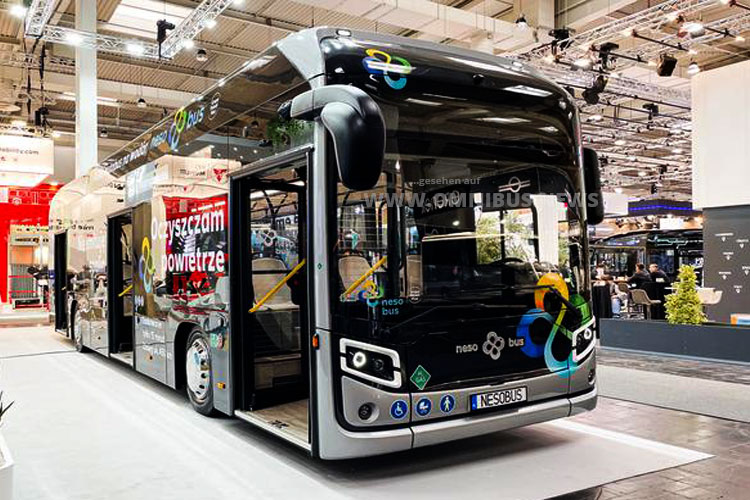
The Polish brand NesoBus showed an FCEV bus in Hanover. Photo: omnibus.news/Schrader
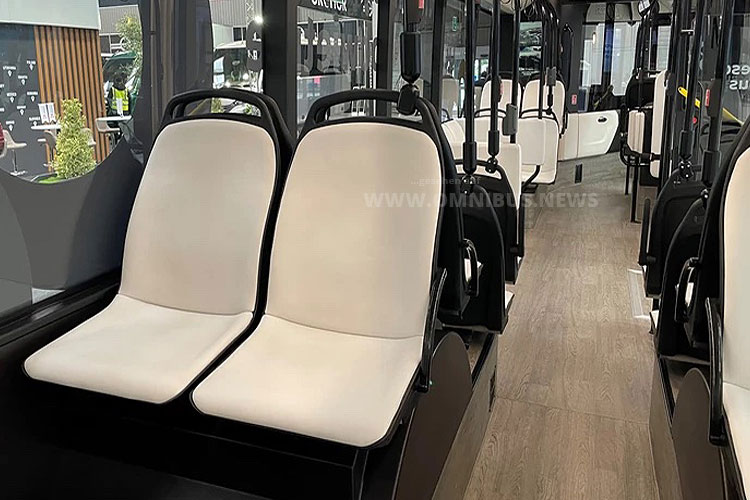
In the interior, nesoBus has used a lot of plastic, right down to the seat cushions. Photo: omnibus.news/Schrader
Quantron also focuses on trucks, but the Cizaris was on display in Hanover for the growing e-bus business. Several orders for the Cizaris 12 EV had been received in advance, and the company was optimistic about the coming days.
Quantron is having the electric bus built as a contract work by the Chinese holding company EV Dynamics. At the company’s own plant in Augsburg-Gersthofen, the Cizaris vehicles are then given the design features typical of the brand and customized for Europe.
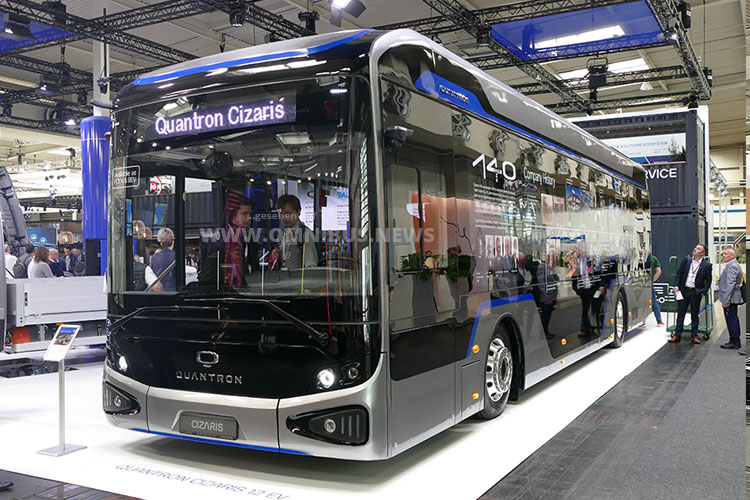
Quantron is having an electric bus named Cizaris made to order in China. Photo: omnibus.news/Schrader
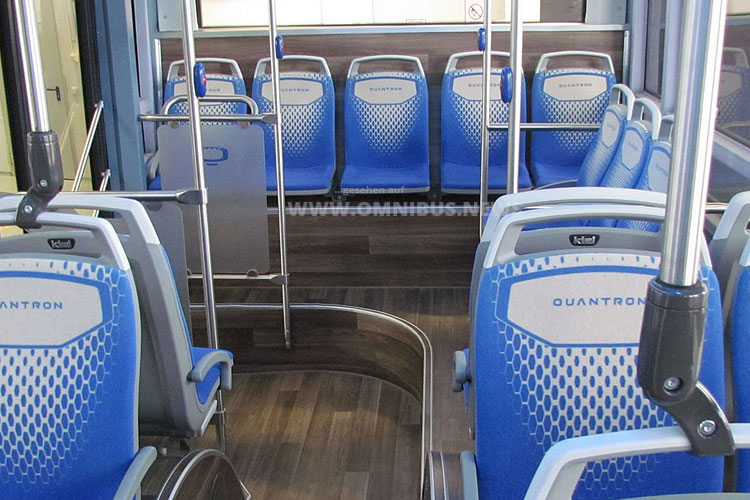
The Cizaris pulls up in front of classic engine tower in the rear. Photo: omnibus.news/Schreiber
Scania showed exactly one bus in the midst of the trucks. Visions are being implemented, according to the corresponding press release. The BEV Citywide is one of them, but at Scania the focus was on commercial vehicles, a total of fourteen vehicles (including one bus) were exhibited.
Eyes up, there’s also a coach in Hall 23 at the IAA Transportation! And what a bus! For propulsion, the Chinese supplier relies on a fuel cell and hydrogen. Sino-Synergy Hydrogen Technology Co., Ltd. (Sinosynergy for short) emphasizes at the trade show in Hanover that the vehicle is the first FCEV coach in Europe.
The rolling base is the Marcopolo Audace with a length of 12m (11.9m, 12.3m or 12.6m are also available) drives forward with a wheelbase of 6,100 to 6,650 mm and a width of 2.5m and height of 3.7m. The propulsion engine has a rated power of 143 kw (peak 235 kw) and a rated torque of 495 Nm (peak 720 Nm). The Sinosynergy fuel cell (type G80-001) is supplemented with four CATL LiFeO storage batteries (lithium-iron type).
Four hydrogen tanks (currently designed for 700 bar) in the luggage compartment of the bus hold the hydrogen. Sinosynergy gives a range of up to 600 km, and refueling takes five minutes. Depending on the application, four to seven cylinders with hydrogen (at 700 bar) are then on board. The luggage compartment is then largely occupied with technology, but two to ten cubic meters of stowage space will remain in any case, as it was said in Hanover.
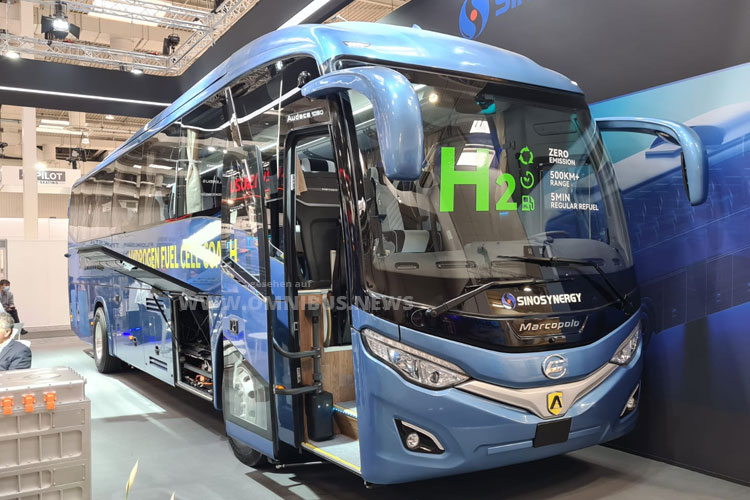
Sinosynergy presented an FCEV coach based on a Marcopolo Audace at IAA Transportation. Photo: omnibus.news/Schreiber
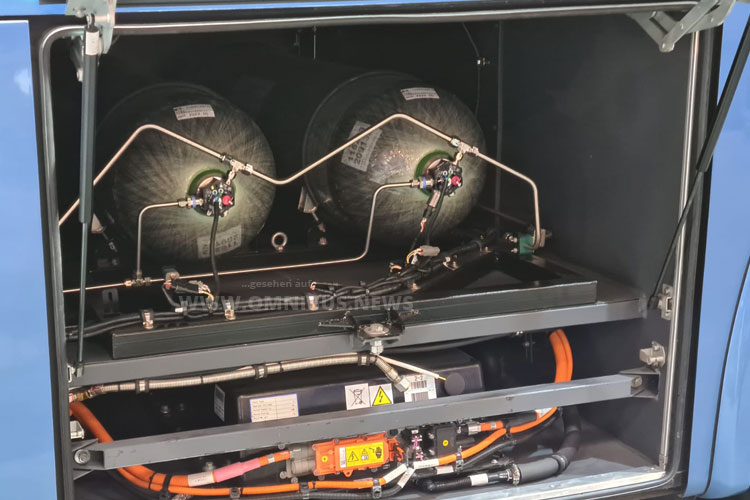
The hydrogen tanks were installed in the luggage compartment at right angles to the direction of travel. Photo: omnibus.news/Schreiber
Steyr Automotive’s appearance at the IAA was a bit of a surprise: The Austrians presented a first vehicle of a new electric bus series, which is to be launched in 6, 9 and 12m lengths. According to Steyr Automotive, however, there is no set production start date yet.
Production startup is planned for the second half of 2024, and the battery-electric drive system is designed for a range of 100 to 250 km, according to the statement in Hanover. At present, no details can be given about further technical details and components that will be used.
It remains exciting in the truest sense of the word, further details on the planned models and vessel sizes as well as technical details including background information and the story behind Steyr Automotive will be available shortly on omnibus.news in one of the other reports on the IAA Transportation.
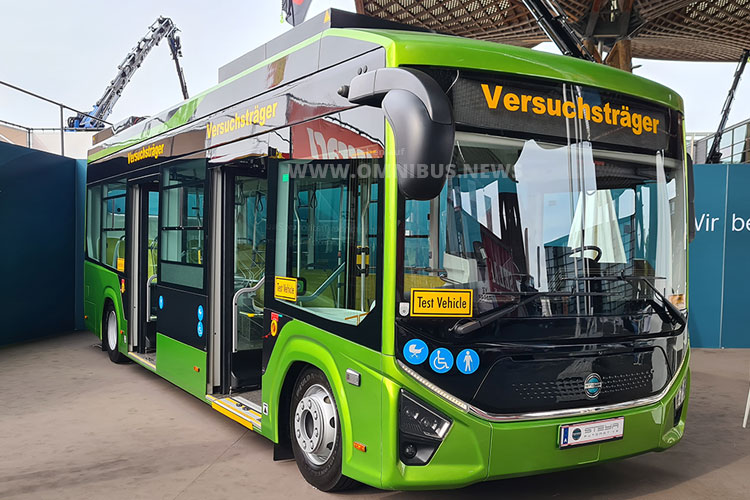
Steyr Automotive announced a new e-bus series and presented a test vehicle. Photo: omnibus.news/Schrader
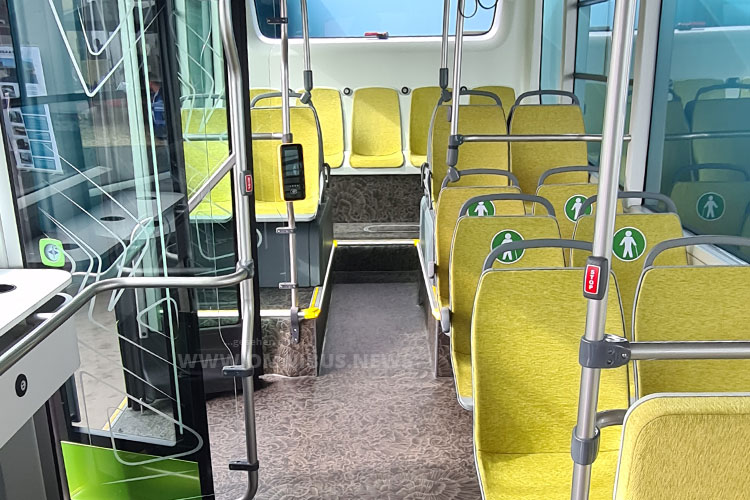
Light-flooded and low-floor, that’s how Steyr Automotive envisions the passenger compartment. Photo: omnibus.news/Schreiber
There was an exciting premiere at the Temsa stand: The LD SB E is a battery-electric bus that will take to the road across the country. The Turkish bus manufacturer also sees growth for itself in the electric bus segment. By 2025, half of the buses delivered are to be zero-emission vehicles.
The Temsa LD SB E is offered as either a 12.3m or 13m vehicle. The NMC batteries with 350 kWh are located in the rear and in the luggage compartment, and the E-Überland is to be fully charged within two hours. For the motor, Temsa in Hanover named a peak power of 250 kW.
The 13m variant on display in Hanover offers up to 61+2 seats, while the 12.3m LD SB E has a capacity for 57+2 passengers. The question of all questions was also here the range: 350 km is said to be it, whether determined according to SORT or a comparable test cycle, the Turks did not answer.
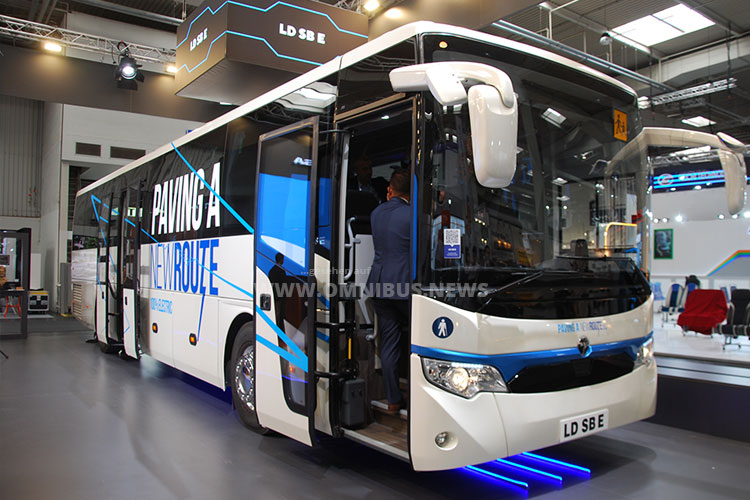
The Temsa LD SB E takes you across the country on battery power. Photo: omnibus.news/Schrader

In the Temsa LD SB E, the passenger compartment remains unchanged. Photo: omnibus.news/Schrader
So much from Hanover as a first impression of the IAA Transportation – not complete and representative, which is due to the upcoming visit to InnoTrans. What do you take away as an impression? Many manufacturers had significantly reduced their presentation areas, well-known suppliers, including small bus manufacturers or builders, were no longer to be seen. And Asian bus builders were almost completely absent, but manufacturers from Turkey shone – according to their own statements, they were surprised that the bus industry would no longer be flying the flag in Hanover.
The bus has never been the center of attention in Hanover. The IAA, now called IAA Transportation, has also made a statement itself, albeit indirectly, with this name change or addition: Commercial vehicles are the focus, not buses. Not even the VDA as organizer of the fair managed to present the omnibus adequately on its website in the news during the first two days or in the first issues of its own fair newspaper!
A disappointment, many visitors were heard to say at the end of their visit. Those who had come to Hannover especially for buses and coaches at least had a relaxed day at the fair, because the number of buses and coaches on display was manageable. And what about Berlin? There will be a first overview on omnibus.news in the next few days! (omnibus.news/Sr)
Is something important still missing for the first impression?
What needs to be added or corrected? omnibus.news looks forward to receiving your e-mail!
